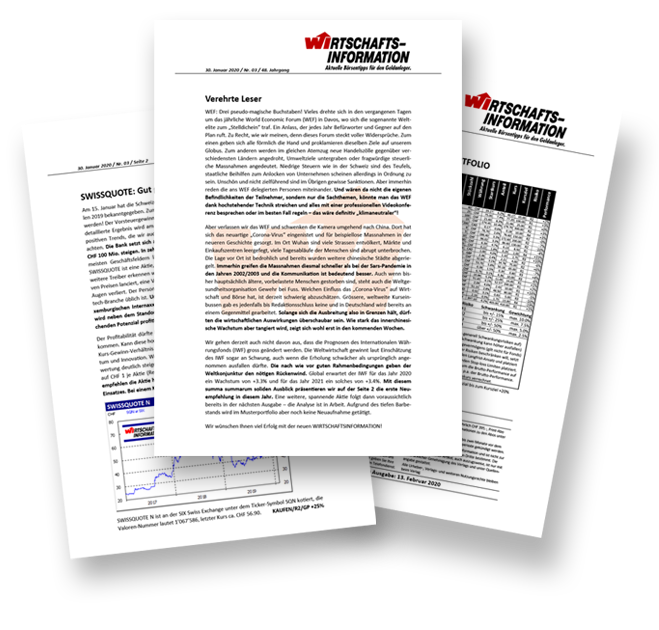Today, we are devoting ourselves to a topic of immense importance, which, however, is rather a "wallflower" on the stock market. With this background information, we then link our new recommendation on page 8. We are all familiar with the general term "fertilizer", but what is actually behind this indispensable "product"? Natural fertilizer - i.e. excrement from animals and humans - has been used in agriculture for thousands of years to increase crop yields. Probably the earliest tradition of fertilization comes from the "Odyssey" by the poet Homer in the 8th century BC; in the farmyard, a pile of manure smelled until the farmhands spread it on the fields. Unfortunately, natural fertilization in agriculture has long been insufficient! Each growth process of a plant extracts important nutrients from the soil. However, as long as nothing is harvested, these substances get back into the soil when the plants decay and fertile humus is created in the undisturbed rhythm of "well-planned nature". However, man has managed to interrupt this natural cycle here as well - although inevitably due to the increasing population. With the sometimes large-scale cultivation of fields, which is followed by harvesting, the various nutrients are literally carried off the field. Depending on the nutrient richness of the soil, it is "exhausted" after only a few harvests. As a result, the most important nutrient elements such as potassium, nitrogen, phosphorus, sulfur and calcium have to be added artificially! Also trace elements such as copper and zinc must not be missing. Furthermore, arsenic, lead, cadmium, mercury and thallium are considered "primarily relevant", but more in the sense that these "heavy metals" can be very toxic for the micro-organisms in the soil... and thus also become dangerous for humans and animals.
Basically, there are three types of fertilizers: Organic, gaseous and mineral fertilizers. The former consists of the natural substances we are most familiar with, which accumulate in the garden (compost), in agriculture (liquid manure, dung) and in the household. The same category also includes sewage sludge, rapeseed cake (produced as a by-product during the cold pressing of rapeseed oil), animal meal and vinasse (a by-product from the further processing of sugar beet molasses). The "gas fertilizer" is primarily used in cultivation under glass halls; if there is an insufficient supply of fresh air, aCO2 deficiency occurs here. Remains the "mineral fertilizer", which is industrially produced from minerals, salts and, as for example nitrogen, from products of the chemical industry... and this is indispensable today!
The artificial fertilizer had its breakthrough already in the 19th century, thanks to the visionary and chemist Justus von Liebig. However, he still made some serious mistakes. Nevertheless, he set "agricultural chemistry" on the path to further development in the 20th century. In this way, Adolph Frank was able to open up potash salt for agriculture. The potassium bound in potash salt is one of the most important nutrients for plants! The chemist Wilhelm Ostwald also did pioneering work in the field of ammonia synthesis: ammonia is the most important precursor for nitrogen fertilizer, which is still the most important mineral fertilizer today and accounts for more than half of the fertilizers consumed worldwide. However, research is far from over, as exciting developments are already underway in the field of classical plant nutrients. One very important one involves the active ingredient class of bio-regulators... where one of our pharmaceutical favorites BAYER is also very successful: while classical nutrients force the growth of the plant in general, bio-regulators act specifically on certain growth processes, such as the formation of the fruit, the sprouting of the roots... and the longitudinal growth of the culms. Chlormequat, which has been used for decades in cereal crops, limits the length growth of the stalks, which offers two main advantages: On the one hand, the plant does not waste energy unnecessarily to build up straw, and on the other, it is better protected from wind. The water requirement is also noticeably lower, which is definitely an advantage during periods of drought. However, we leave it open whether all the artificial interventions in the given processes of nature are really useful... but there is probably no alternative!
A word about the dangers: Elementary important is the handling of the storage and especially the application of fertilizers. Improper handling can lead to serious damage to the plant individually as well as to the environment as a whole. If too much fertilizer is spread, there is a risk that the plants will not be able to absorb the nutrients and, above all, that the nitrogen, in the form of nitrate, which is undesirable in drinking water, will get into the groundwater. Sparing use and a dosage adapted to plant requirements are therefore particularly important in order to prevent negative effects on soils, waters, climate and biodiversity! Our new recommendation has long since left the "legacy" behind and is performing in an exemplary manner in terms of potash mining, water protection, resource efficiency, energy and climate. The ESG ratings are well above average!
NUTRIENTS IN THE SOIL: "No fertilizer, no bread"!

The Swiss stock market letter WIRTSCHAFTSINFORMATION
- Every 14 days 10-12 pages of stock market tips for shares, precious metals and commodities
- Profit, risk assessment per stock recommendation
- Editorial with market assessment
- Actively managed sample portfolio
- Stock market tips + stock recommendations formulated in an understandable way
- Advertising-free, independent and objective To thereading sample